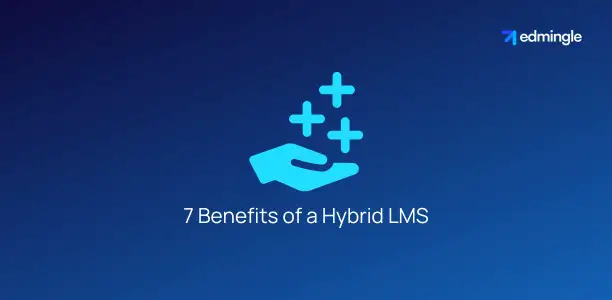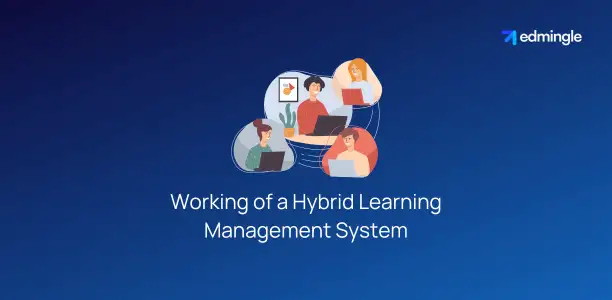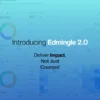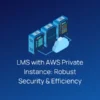
Today, the line between virtual and physical classroom is slowly blurring. In such a scenario, hybrid learning management systems are proving to be a game-changer.
Hybrid LMSs not only revolutionize the way we approach teaching and learning. But also combine the authenticity of face-to-face education with the flexibility of online.
These LMSs present a shift; catering to diverse styles and modern needs.
By the end of this blog, you’ll gain a deep understanding about hybrid learning management systems. Along with their benefits, best practices and more.
What is a Hybrid Learning Management System?

A hybrid LMS is not just a regular LMS. It’s an integrated educational approach.
One that seamlessly blends the tried-and-true methods of conventional classroom teaching. With the expansive capabilities of online learning.
It helps deliver the best of both worlds. The personal touch of face-to-face lessons combined with the accessibility & adaptability of online courses.
Learners can gain more from the immediate feedback of classroom interactions. While also benefiting from the convenience of accessing resources at anytime, from anywhere.
Read more about E-learning Accessibility.
What does Hybrid Learning Mean?

Ever tried mixing your favorite fruit juices together? You might discover a blend that’s sweeter, richer, and more refreshing than any single flavor alone.
Hybrid learning is sometimes referred to as “Blended Learning”. It’s a teaching method that integrates the interaction of traditional classes instruction with the convenience of online.
The term “hybrid” originates from the fact that it doesn’t fully reside in a brick-and-mortar environment. And nor is it wholly online.
Instead, it merges the strengths of both to eliminate their individual limitations.
Read more about the difference between teaching and training.
What does Blended Learning Mean?

As the name suggests, it is a fusion. The blended learning approach, too, mixes the best of two worlds: face-to-face teaching and e-learning.
Now, you might be thinking, “Isn’t this similar to the hybrid method?” Indeed, the terms “Blended” and “Hybrid” are often used interchangeably.
But their implementation and the extent to which online resources are utilized can vary.
Related Article: Hybrid Learning vs Blended Learning.
Think of Blended Learning as the broader umbrella term, with Hybrid Learning as one of its most effective manifestations.
7 Benefits of a Hybrid LMS

The emergence of hybrid learning environment offers a multifaceted approach to education. This is making learning more accessible, flexible and engaging.
Here, we explore the key benefits of implementing a Hybrid LMS.
- Accessibility and Flexibility: A standout benefit of a hybrid LMS is its ability to break down location & time barriers. Learners can access materials as per their convenience.
- Enhanced Educational Experiences: Hybrid LMS platforms are designed to cater to a variety of learning styles. Learners can engage with the material in a way that suits them best.
- Improved Communication and Collaboration: These platforms enable better communication between students and instructors. Through discussion forums & chat rooms, learners can collaborate on projects, share insights, and seek support.
- Cost-Effectiveness: With online components, educational institutions & universities can reduce physical resource requirements and operational costs. This can lead to more affordable education options without compromising the quality.
- We’re thrilled to share that using Edmingle for your training delivery can reduce your operational cost by 20%.
- Data-Driven Insights: Hybrid LMSs come equipped with analytics and reporting tools. These provide valuable insights about learners/courses.
- Scalability: As a business grows and evolves, so does a hybrid LMS. These systems are designed to accommodate hybrid courses & users without a loss in performance.
- Also read about Edmingle’s scalability and flexibility.
- Continuous Improvement: The digital component of a hybrid LMS allows for continuous content updates and improvements. This ensures that learners always have access to the most current information.
In short, by blending the best aspects of both into hybrid education. A hybrid LMS provides a versatile, engaging, and effective learning environment.
8 Essential Features of a Hybrid LMS Platform
The advantages of integrating a hybrid LMS are evident from the section above. But the question of key features to look out for remains unanswered.
But not in our blog. This section delves on the key LMS features to look out for before integrating a hybrid LMS.
| 1.Multi-Modal Content Delivery | Look forwards to hosting content in multiple formats. Be it video lectures, interactive modules, e-books, podcasts, or simulations. Also, make sure the offline and online components are synchronized seamlessly. |
| 2.Personalized Learning Experience | A hybrid LMS should gauge a student’s performance and modify content delivery accordingly. Hence ensuring that learning is tailored to individual needs. |
| 3.Collaborative Tools | Look for interactive forums. For learners to engage in discussions, ask questions or collaborate on group projects. A peer review system further enables students to review each other’s assignments. Thus, fostering a culture of collaborative learning and feedback. |
| 4.Comprehensive Assessment Modules | Using traditional quizzes & interactive assessments, students can be evaluated in varied ways. And immediate feedback ensures they understand areas of improvement without delay. |
| 5.Mobile & Offline Compatibility | A device-responsive design facilitates mobile learning. Furthermore, with offline access, learners can access materials without an internet connection. |
| 6.Data-Driven Insights | Learners can view their performance, mark important sections and track their progress. Instructors, too get these insights through a main dashboard. To know more on this, check our blogs on: –Using Data Analytics to Personalize Learning. –LMS Engagement Metrics. |
| 7.Security & Scalability | Advanced security measures protect learner data as well as content on the platform. Along with expanding capabilities without compromising on performance. |
| 8.Seamless Integrations | A hybrid LMS must integrate with online tools like calendars, email platforms, or other edtech solutions. This ensures a unified learning ecosystem. |
Understanding these features can help you harness the full potential of a hybrid learning management system.
Working of a Hybrid Learning Management System

After reading all about the hybrid learning experience, there is one question that intrigues our minds. “But how does it function on a day-to-day basis?”.
Let’s explore the working of this innovative approach.
1.Dual Platforms for Delivery: A Hybrid Learning Model operates on two primary fronts:
- Traditional Classroom: This is the setting we’re all familiar with. Students gathered in a physical space with instructor-led training. An instructor delivers lessons, facilitates discussions or oversees group activities.
- Online/Virtual Classroom Platform: Typically powered by an LMS for hosting a variety of resources like video lectures, pdfs, quizzes and more. Students can access them at anytime, from anywhere, with an internet connection.
2.Flexibility in Learning Paths: One of the standout features of the hybrid model is its adaptability. This includes:
| i.Customized Schedules Depending on the course or institutional guidelines. Students might have the freedom to choose between in person learning or virtual learning. | ii.Personalized Pacing For the online portion, learners often have the liberty to move through materials at their own pace. They can revisit topics when needed or move ahead if they’re comfortable. |
Also Read: The perfect LMS strategy for balancing between screen-time and hands-on learning.
3.Diverse Assessment Methods: Hybrid learning doesn’t just diversify teaching methods. It also introduces varied ways to evaluate comprehension. It includes:
- Digital Assessments: Platforms like Edmingle offer features like online quizzes, exercises, assignments & assessments.
- In-person Instructions & Evaluations: Traditional tests, group presentations or hands-on projects in a physical setting.
Since we’re talking about assessments. Here’s a comprehensive guide on overcoming challenges in online assessments and proctoring.
4.Collaborative Tools & Platforms: Hybrid learning leverages technology to foster collaboration. It makes efficient use of engaging techniques like:
| i.Discussion Forums Online platforms might host forums. Where students can discuss topics, share resources or pose questions. | ii.Virtual Group Projects Tools like shared documents or video conferencing enables students to collaborate on projects. Without being in the same physical space. |
5.Continuous Feedback Loop:In a hybrid model, feedback isn’t limited to periodic report cards. But it goes a level further with the following:
- Instant Feedback: Digital quizzes or assignments can offer immediate feedback. Thus, enabling students to understand mistakes & rectify quickly.
- Regular Check-ins: Instructors can now schedule one-on-one virtual meetings with students, on a regular basis. To discuss progress, address concerns or offer guidance.
You might also like to read about the power of feedback in e-learning.
In short. The hybrid learning model retains the human connection & interactive nature of traditional classrooms. While embracing the flexibility & technological advantages of online education.
5 Top Hybrid LMS Platforms in 2024

The future of education and training is hybrid. And as institutions and organizations worldwide navigate the challenges of remote learning. The role of an LMS becomes critical.
If you’re in search of the best hybrid LMS solutions, look no further. Here, we’ve compiled a list of the top 5 platforms to consider in 2024.
1.Edmingle
Edmingle, a fast becoming favorite in the LMS realm. Designed with both educators and learners in mind, it offers an intuitive interface. With a wide range of features and integrations, it aims to make hybrid learning seamless.
It’s a robust SaaS LMS with which you can build, manage & scale your hybrid training programs effortlessly. And that too, under your own brand with its 100% white-labelling.
2.EducateMe
EducateMe offers a dynamic environment and facilitates seamless integration of various tools. Hence, fostering an engaging and interactive learning experience.
3.360 Learning
360Learning offers a robust platform for crafting training programs. It provides a seamless integration of offline, online & hybrid training methods.
4.TalentLMS
TalentLMS offers gamification features and is ideal for creating an engaging & effective training experience for students.
5.iSpring Learn
iSpring Learn provides unparalleled ease of use alongside robust features. Hence enabling dynamic and effective learning programs.
These were just the top 5 hybrid LMS platforms. However, there are plenty of other platforms out there that you can check.
8 Steps to Select the Right Hybrid Learning Management System For You
Choosing the right hybrid LMS for you is a challenging process. But not with the 8 steps mentioned below.
| 1.Identify Your Learning Outcomes: Understand the specific objectives you aim to achieve with the LMS. | 5.Consider Integration Capabilities: Ensure the LMS can seamlessly integrate with other tools and systems. |
| 2.Assess User Needs: Consider the needs & tech expertise of all users, including students, instructors, and administrators. | 6.Review Support and Training: Check the level of technical support provided. |
| 3.Evaluate Features: Look for essential features that support both the online and offline learning process. | 7.Analyze Cost: Evaluate the cost against your budget and consider the total cost of ownership. To know more about this, check our blog on LMS pricing. |
| 4.Check for Scalability: Choose an LMS that can grow with your institution. Without compromising performance. | 8.Request Demos and Trials: Before making a final decision, an LMS demo helps assess the system’s functionality. It also ensures if it meets your needs. |
By carefully considering these factors, you can make an informed decision and select the right hybrid LMS. One that aligns with your educational goals.
Since we talked about support in this section. We’re thrilled to share about Edmingle’s exceptional approach to customer support and service.
Summary
As we conclude our exploration of hybrid learning management systems. The blurring lines between traditional and virtual classrooms indicate a new approach.
One that blends the authenticity of in-person training with the flexibility and accessibility of online learning. And a hybrid LMS does that effectively.
The importance of adopting such a system only increases as we progress through the modern age. And with the right one, your business can become future-ready.
FAQs on Hybrid LMS
1.How does a hybrid LMS differ from a traditional LMS?
While both types of systems are designed to facilitate learning. A traditional LMS primarily focuses on online learning. In contrast, a hybrid LMS allows for a more flexible and adaptive virtual learning environment.
2.Why should institutions or businesses consider using a Hybrid LMS?
Adopting a Hybrid LMS provides several benefits. This includes greater flexibility for learners with the adaptability to diverse learning styles and preferences. It also brings in enhanced student engagement and can be highly cost-effective in the long run.
3.What are the specific industries or sectors that benefit most from hybrid LMS platforms?
It can be advantageous for many sectors. But mostly for sectors with a diverse set of learners, remote or international students. Or those looking to offer continuous training to employees (like IT industry, MNCs, or higher education institutions).






Leave a Reply